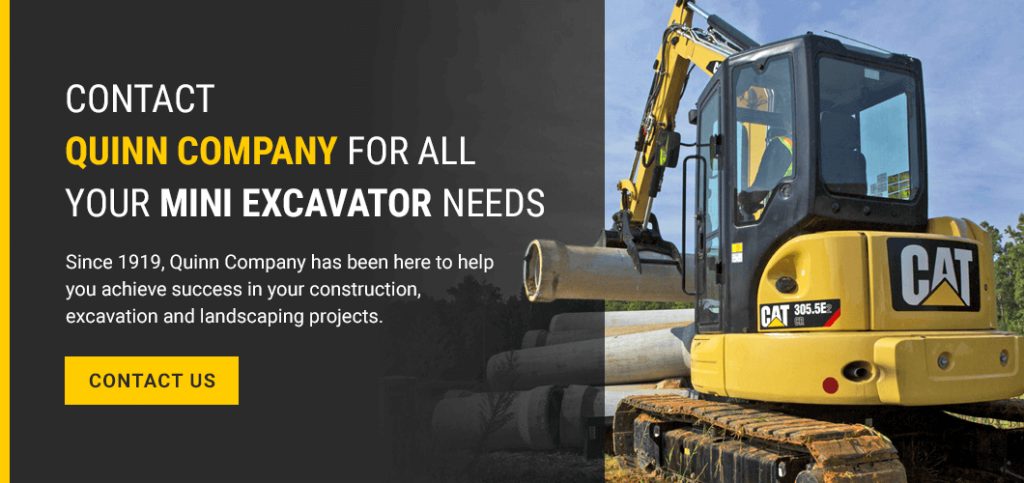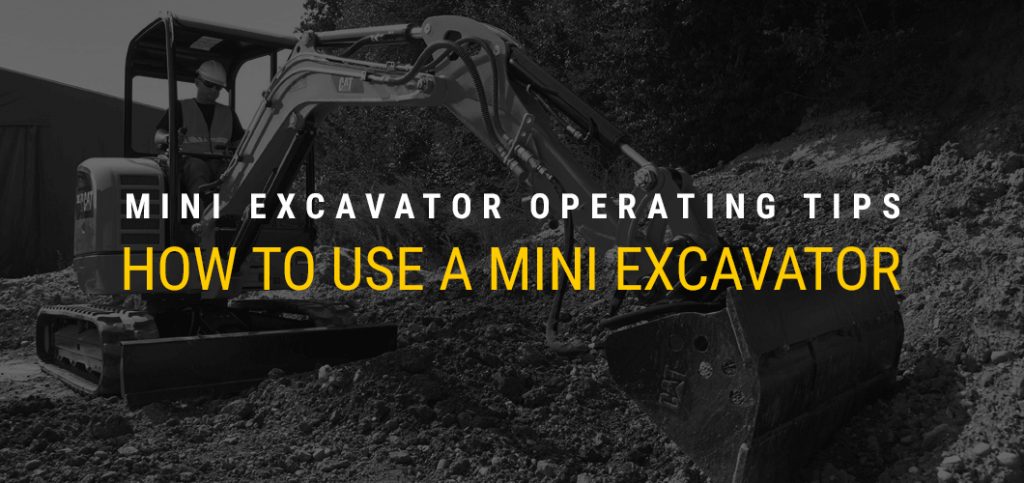
On construction jobs with tight deadlines and high quality standards, you need to have a way to get more done without wearing out employees. You also need lightweight, maneuverable equipment that can fit through gates, travel over rough ground and turn without damaging surrounding structures or equipment.
Mini excavators are often the perfect solution. They provide the power you need to get jobs done efficiently while offering exceptional maneuverability and minimized damage. In the guide below, we’ll explain how to operate a mini excavator, and discuss how these machines can benefit a variety of projects.
Jump To Sections:
- What Is a Mini Excavator?
- Mini Excavators vs. Standard Excavators
- How to Use a Mini Excavator
- Mini Excavator Operating Tips
- Contact Quinn Company for All Your Mini Excavator Needs
What Is a Mini Excavator?
A mini excavator is a versatile piece of equipment often used in construction projects. Lighter and smaller than a standard excavator, it can perform a variety of essential functions with ease. Mini excavators generally include several main components:
- Cab: Users sit in the cab to operate the mini excavator.
- Engine: The engine powers the mini excavator, allowing the operator to control the boom and drive using the hydraulic tracks.
- House: The house of the mini excavator holds the cab, engine and hydraulic cylinders. It is mounted on a pivot above the undercarriage and can rotate a full 360 degrees.
- Undercarriage: The bottom of the mini excavator connected to the house is known as the undercarriage. It supports the machine’s weight and holds the motor, gears and track roller that allow the mini excavator to move.
- Stick: The stick is the long hinged and hydraulically operated arm. It can connect to different attachments like trenching buckets, grapples, thumbs, and blades. The stick connects to the boom.
- Blade: The blade of a mini excavator attaches to the undercarriage. It is useful for grading, and it can be positioned at the front or back of the mini excavator to provide stability during digging.
Mini excavators come in different sizes and weights, so you can easily get the machine that’s right for your project’s needs. You can also rent a mini excavator if the purchase price doesn’t fit your budget. About 40% to 50% of the market for mini excavators is rentals, so you’ll be able to find the options you need in a rented machine.

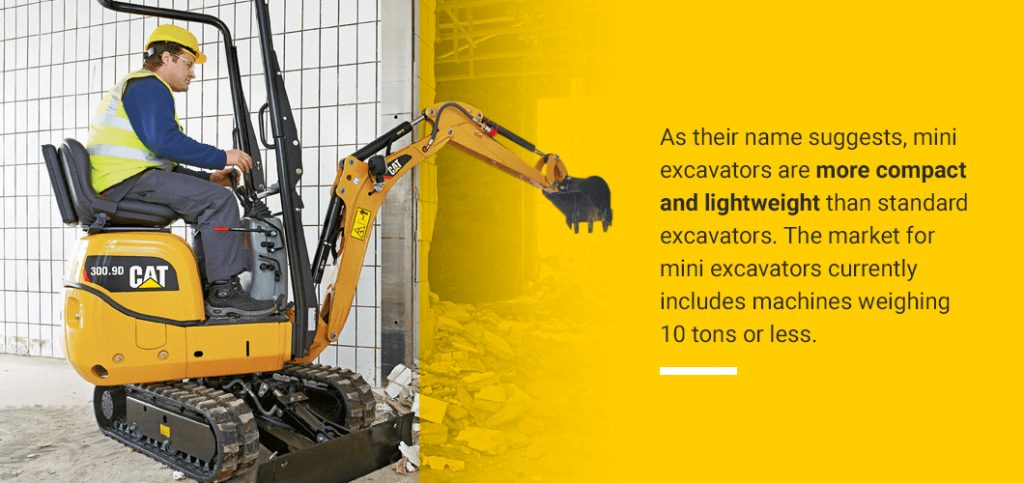
- Size: As their name suggests, mini excavators are more compact and lightweight than standard excavators. The market for mini excavators currently includes machines weighing 10 tons or less.
- Attachments: Mini excavators can accommodate a variety of attachments that boost their utility.
- Environmental impact: Because of their lighter weight, mini excavators tend to make less impact on the environment. Mini excavators leave fewer and lighter track marks and do less damage to soil and plants.
- Site suitability: Because they are smaller, mini excavators can be useful to have on more compact or crowded sites. They are easier to tuck into corners and won’t get in the way of other equipment.
- Maneuverability: Mini excavators tend to be easier to maneuver, especially around other objects and vehicles. Mini excavators can also move through crowded lots with ease.
- Transportation: Because of their lighter weight, mini excavators are easy to load into trailers and transport to and from the job site. Where a standard excavator may be too heavy for a trailer or utility truck to accommodate, a mini excavator may be light enough.
How to Use a Mini Excavator
You can get started with using your mini excavator by following these steps:
- Lower the blade: Use the control lever to lower the blade until it tilts the machine up slightly.
- Use the throttle for power: If you are new to using a mini excavator, consider using half power for a while until you get more comfortable operating the machine.
- Position the stick and bucket for excavating: To start excavating, push the primary stick to extend the stick outward. When the stick is about halfway extended, use the bucket control to angle the bucket. Lower the boom until the bucket’s teeth meet the ground. Use the joysticks to finesse your angle as needed.
- Dig with the stick: Pull on the stick to make the bucket dig into the earth. Then pull the primary boom lever to maintain your grade. If you have a swing boom or variable-angle boom, you can swivel the boom and dump the dirt. Or turn the mini excavator and drive the dirt to the established dumping location.
Mini excavators’ light frames and extensive arrays of attachments make them versatile enough for use on many different job sites. Below are a few different uses for mini excavators:
1. Digging Holes
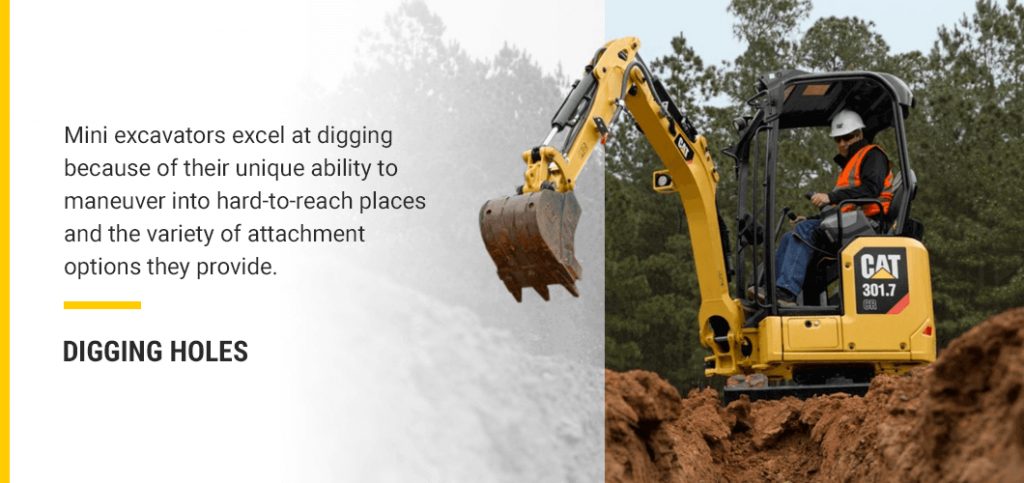
Mini excavators excel at digging because of their unique ability to maneuver into hard-to-reach places and the variety of attachment options they provide. Old-fashioned shoveling is tedious and exhausting, and this method of digging could dramatically extend a project’s completion time. But digging with a mini excavator is efficient and effective.
2. Landscaping
Mini excavators help make landscaping quicker and less laborious. Rather than shoveling dirt by hand, you can use a mini excavator to dig for planting trees and shrubs or for irrigation ditches. A lightweight mini excavator can also maneuver around the property without leaving heavy track marks or damaging the soil or plants.
3. Demolishing Structures
Mini excavators are useful for demolition as well. Though you’re unlikely to use a mini excavator to demolish a full-sized building, many construction projects require tearing down smaller structures like sheds and other outbuildings. Mini excavators are much more efficient and safer than using hand-powered tools to take small structures apart, and their compact size means they can maneuver through gates and tight spaces on the job site.
4. Installing Outdoor Structures
When a project calls for installing structures like pools and hot tubs, you need a convenient, effective way to excavate all that dirt. Mini excavators can help. Shoveling would be a tiring, time-consuming effort, but a mini excavator can get the job done easily. And it won’t tear up the surrounding dirt or get stuck trying to get to the excavation site.
Mini Excavator Operating Tips
Knowing the best methods for approaching work with your mini excavator is vital — it helps you get the best performance out of your machine. Here are a few helpful tips for operating a mini excavator:
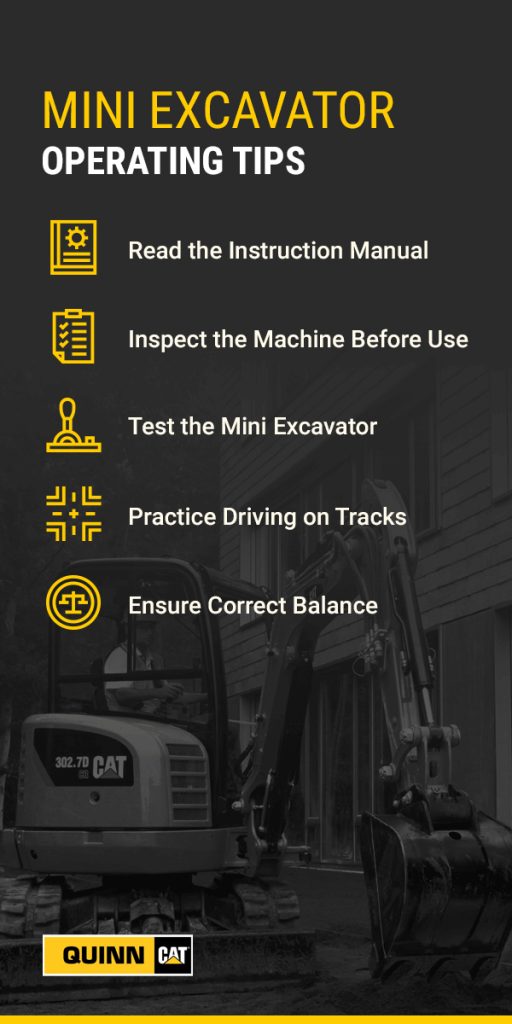
1. Read the Instruction Manual
The operator’s manual often contains valuable information about how to use a mini excavator. It tells you how to use each control, where warning labels and fire extinguishers are located and the conditions under which you should and should not operate the machine. A thorough reading is often beneficial. But even if you don’t read every word, be sure to take a look through the manual and make sure you understand the basics of the mini excavator’s operation.
2. Inspect the Machine Before Use
As with any vehicle or piece of machinery you operate, you should make a habit of looking over your mini excavator frequently. Check for loose hoses or fluid leaks that could pose hazards and impair your machine’s performance. Check the oil, lubricant and coolant levels, and inspect the tracks for damage.
3. Test the Mini Excavator
Before using your mini excavator for the first time, it’s a good idea to test it and become familiar with how it works. Different makes and models have different layouts, so your latest mini excavator may differ from the last one you used. You can test the machine in a large, flat and open area. Try out all the controls, and practice moving the boom and rotating the cab. Getting a feel for how the mini excavator responds to controls helps make your work more precise, reduces overcorrection and improves safety.
4. Practice Driving on Tracks
Most mini excavators drive on rubber tracks, which handle considerably differently than wheeled axles do. The right and left tracks can even move separately to improve turning. If you’re new to mini excavators, practice driving so you can get a good feel for how the tracks respond to the controls and the terrain.
5. Ensure Correct Balance
Especially with smaller machines, if you don’t balance the weight of your mini excavator correctly, you can end up tipping. Be sure to balance your mini excavator by extending or retracting the stick.
Contact Quinn Company for All Your Mini Excavator Needs
Now that you’ve read some mini excavator tips, it’s time to put them into action. To see the benefits of using a mini excavator for your next project, partner with Quinn Company.
Since 1919, Quinn Company has been here to help you achieve success in your construction, excavation and landscaping projects. We offer an extensive catalog of mini excavators with a range of sizes and capabilities. And we back our equipment with factory-trained staff ready to lend on-site support, as well as the most comprehensive parts in the industry.
Contact us or give us a call today at 888-987-8466 to learn more or visit one of our convenient locations.


